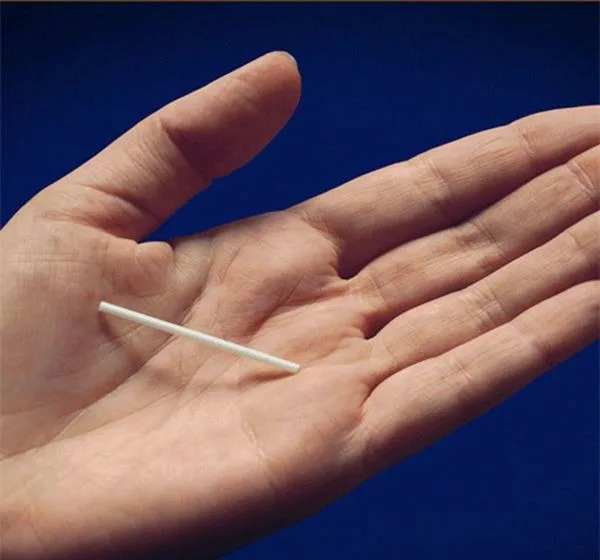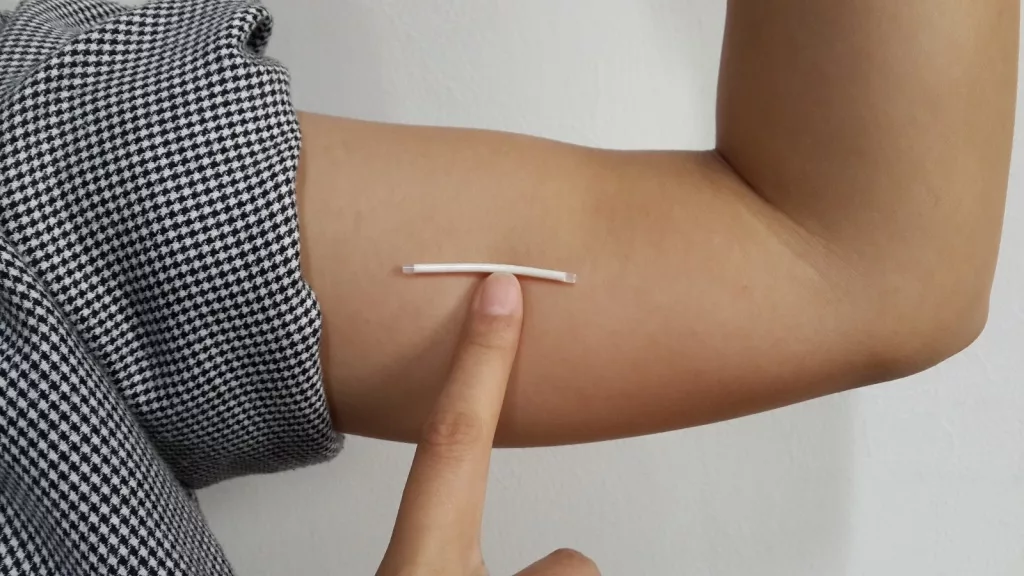Contraceptive Implant Insertion in Warsaw
Are you looking for information about contraceptive implants in Warsaw? In this article, you’ll learn everything you need to know before deciding to get an implant: what a contraceptive implant is, how the procedure is performed, its benefits, possible contraindications, and how to take care of yourself afterward.
Book Your Contraceptive Implant Appointment ⬇️
Key Information – What Is a Contraceptive Implant?
A contraceptive implant is a small, flexible rod about 4 cm long, placed under the skin of the upper arm. This plastic rod acts as a subdermal birth control implant. It contains the hormone progestogen, which is gradually released into the body, preventing ovulation and effectively protecting against pregnancy.
The implant is a long-term, discreet, and convenient option for women who don’t want to remember to take contraception daily. Unlike other methods, it doesn’t require regular intake of pills. It is a modern and highly effective form of hormonal contraception, considered one of the most reliable contraceptive methods available on the market.
Advantages of the Contraceptive Implant:
Over 99% effective
Provides protection from pregnancy for 3 to 5 years, depending on the type of implant
Discreet – the rod is invisible under clothing
Fertility returns quickly after removal
No impact on daily life – no need to remember to take pills
How Does the Contraceptive Implant Work?
The implant contains the hormone progestogen, which is gradually released into the body, preventing ovulation and protecting against pregnancy. This hormone works by affecting the cervical mucus and the lining of the uterus.
The implant releases progestogen, which:
Prevents ovulation – the ovary does not release an egg.
Thickens cervical mucus – making it difficult for sperm to reach the uterus.
Changes the uterine lining – reducing the chance of a fertilized egg implanting.

The active substance in the implant belongs to the group of sex hormones and is gradually released to prevent pregnancy.
Thanks to these mechanisms, the implant provides high effectiveness and stable protection for several years.
Types of Contraceptive Implants
There are several types of contraceptive implants available on the market, differing in active substance, duration of action, and method of application. The most commonly chosen option is the subdermal implant – a thin, flexible rod inserted under the skin of the upper arm by a doctor. This implant gradually releases the hormone progestogen, providing effective protection against unwanted pregnancy for several years.
Other types of implants also exist, such as intrauterine implants, which are placed directly in the uterus. Choosing the right implant should always be preceded by a consultation with a gynecologist, who will consider individual needs, health status, and personal preferences. This ensures that every woman can find the contraceptive implant best suited to her lifestyle.
How Is the Implant Inserted?
The insertion of a contraceptive implant is performed in a medical office and usually takes 15–20 minutes. The procedure is done under local anesthesia, and the implant is placed on the inner side of the upper arm. The insertion is minimally invasive and generally well tolerated by patients.
Step by Step:
1. Medical Consultation
The doctor assesses your health, reviews your medical history, rules out contraindications, and selects the appropriate type of implant. Possible side effects are discussed, and any questions from the patient are answered.
2. Preparation of the Insertion Site
The upper arm is cleaned and disinfected. The doctor marks the insertion site to ensure the implant is placed correctly under the skin.
3. Local Anesthesia
A local anesthetic injection or numbing cream is usually applied to minimize discomfort during the procedure.
4. Implant Insertion
The implant is inserted under the skin using a special applicator. The procedure takes just a few minutes.
5. Check and Dressing
The doctor ensures the implant is correctly positioned and covers the insertion site with a dressing. The patient receives instructions on caring for and monitoring the area.
After the Procedure: What to Expect
Mild bruising or swelling at the insertion site
Occasionally, slight pain or discomfort
No need for daily checks of the implant
Follow-up visits are recommended after a few weeks and then every few months
Contraindications and Safety
The contraceptive implant is safe for most women, but there are certain contraindications, including:
Unexplained vaginal bleeding
Thromboembolic disease or history of blood clots
Suspected hormone-dependent malignant tumors
Hypersensitivity to the active substance
Liver disease
Hormone-dependent cancers
Before using an implant, a detailed consultation with a gynecologist is required to assess the individual situation. The decision to use the implant should always consider the patient’s personal health and circumstances.
When to Consider a Contraceptive Implant
The contraceptive implant is recommended for women who:
Are looking for long-term protection against pregnancy
Do not want to remember to take daily contraceptive pills
Have difficulty using other forms of contraception
Prefer a discreet method that is not visible to their partner
The optimal timing for implant insertion depends on the individual’s situation, menstrual cycle, and previous use of other contraceptive methods. Proper scheduling and procedure should be tailored to each woman’s needs and health status.

Costs and Reimbursement
When considering a contraceptive implant, it’s important to take the costs of the procedure into account. In Poland, the price of a contraceptive implant usually ranges from 1,000 to 1,500 PLN, depending on the clinic and city.
Although contraceptive implants are not currently reimbursed by the National Health Fund, their high effectiveness and long duration make them a worthwhile investment, as they eliminate the need for regular spending on other contraceptive methods.
It’s also worth checking whether private health insurance covers partial reimbursement for the implant procedure. Before deciding to get an implant, it’s advisable to inquire about the financial details at your chosen medical facility.
Post-Implant Care
After receiving a contraceptive implant, it is important to:
Monitor the insertion site – mild redness or bruising may occur, usually resolving within a few days.
Report any concerning symptoms to your doctor – including side effects such as changes in bleeding patterns, headaches, or breast tenderness.
Attend regular follow-up visits – typically every few months or as recommended by your doctor.
Inform your doctor about new medications – some drugs may reduce the effectiveness of the implant.


Possible Side Effects
Some women may experience:
Irregular bleeding or spotting in the first few months after insertion
Mood changes, such as irritability or emotional fluctuations
Weight gain, often associated with increased appetite
Headaches, abdominal pain, or dizziness
Breast tenderness
Hot flashes
Other side effects related to the contraceptive implant
Most side effects are mild and resolve within a few months. If any adverse effects occur, it is important to consult your doctor.
Optimized for Patients’ Needs
The contraceptive implant is an ideal solution for women seeking a convenient, effective, and long-term method of birth control. Since it does not require daily attention like taking pills or regularly changing patches, the implant allows women to enjoy peace of mind and reliable protection against unwanted pregnancy.
It is also a safe option for breastfeeding mothers, as it does not negatively affect the quantity or quality of breast milk, as confirmed by clinical studies.
However, it is important to remember that every woman has unique needs and expectations. Before deciding to use a contraceptive implant, it is best to consult with a gynecologist. A specialist can help choose the most suitable contraceptive method, taking into account individual health conditions and lifestyle.
FAQ – Frequently Asked Questions
The procedure may cause slight discomfort, but local anesthesia minimizes any pain.
No – the implant is placed under the skin and is not visible to others.
It lasts 3 to 5 years, depending on the type of implant. After that, it can be replaced or removed.
Yes – fertility usually returns within a few weeks after removal.
No – the implant only protects against pregnancy. Condoms are recommended for STI protection.
Implants and IUDs are highly effective and do not require daily attention like birth control pills. Both the implant and IUD are convenient, last for several years, and do not require daily monitoring, whereas pills must be taken consistently. The choice depends on personal preferences and medical considerations.
Yes – the implant can be used while breastfeeding and does not negatively affect the quality of breast milk or the baby’s health.
The implant is highly effective, with success rates over 99%. This effectiveness has been confirmed in numerous clinical studies, making it one of the most reliable contraceptive methods
Summary
The contraceptive implant is an effective, convenient, and discreet method of pregnancy prevention, suitable for women seeking a long-term solution without the need for daily pills. The procedure is quick, safe, and generally well tolerated, and with regular check-ups, it ensures full safety and comfort.